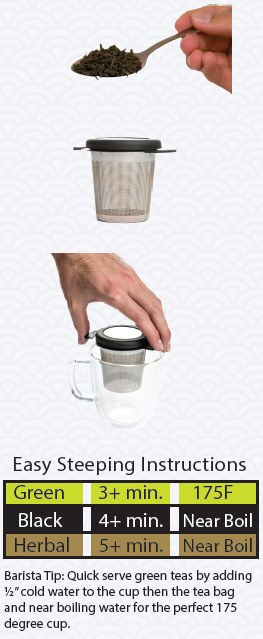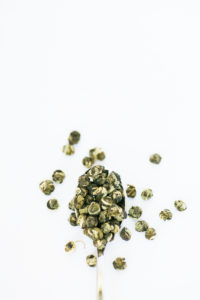Caffeine Content
If you are watching your caffeine intake and wish to eliminate it from your diet, please consider herbal tisanes as an alternative. Decaffeinated tea does still contain some caffeine although low on the scale
| Average caffeine levels per 8 oz serving
|
|
| Brewed Coffee | 60-120 mg |
| Double Espresso | 45-100 mg |
| Black Tea | 45 mg |
| Cola – can | 34-38 mg |
| Flavored Tea | 40 mg |
| Oolong Tea | 30 mg |
| Green Tea | 20 mg |
| Dark Chocolate | 20 mg |
| White Tea | 15 mg |
| Decaf Tea | 5-10 mg |
| Herbal Tisane | 0 mg |
Organic Black Tea B – Spring Pick 2019
Ecological Conditions
Climate: Semi-tropical, overcast foggy
Altitude: 800
Picking Season: Spring Pick (Late March > Mid-May) Fall Pick (Mid-August > Late September)
Location: Jiaocheng Tea District, Fujian Provence, PRC China
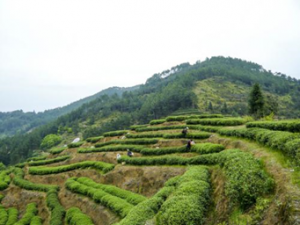
Photo from Mr. Liu (lee-oo), Summit’s central China farmer, of his organic black tea garden where this tea is grown
Picking Season
While teas grow year around, there are two harvest seasons per year. Spring Pick capitalizes on the terrain’s accumulation of fog, abundant rain, and mild temperatures producing the highest quality teas. These conditions are crucial to the plants ability to concentrate nutrients, especially antioxidants and flavonoids, in the leaves. These teas are never picked in the summer months due to how hotter and drier conditions bring out bitterness in the leaves. Summit’s Organic Black Tea B is currently from the 2019 Spring Pick.
Special Handling
As black tea starts as green tea leaves, the picking is timed to cool early mornings when the tea leaves are most tender. Picked teas are spread out on a flat patio and withered (water evaporated) in the sun for approximately one day where they begin to turn brown, much like how a cut apple will turn brown as it oxidizes in the air. The teas are gathered and brought indoors to start the fermenting process that will turn the withered leave into black tea. The process is overseen by the Tea Master who arrests the process at the right time and quickly bakes the leaves dry. In the process, juices from inside the tea leaves come to the surface where they dry, producing a robust first cup of tea. Cases of these bags are sent to the coast of China and then to the Port of LA, where Summit Tea Company picks them up in 5-6 weeks.
History
The process to duplicate the “spoiled tea” European importers found in damp tea casks was first duplicated by tea farmers in the Wuyi Mountain area of Fujian province during the Ming Dynasty (1368-1644 A.D.). Wuyi City, Tongmu Village, and the Jiang family are the production center of a specialty black tea called Lapsang Souchong. Lapsang is important because it lifted black teas into popularity in 1662 when several cases were included in Catherine of Portugal’s dowry. Black tea quickly became popular in the British Court and among the rich. When the British broke the “silver-tea-opium” triangle by growing tea in India, tea became accessible to all.
Organic Dragon Well – Spring Pick 2019
Ecological Conditions
Climate: Semi-tropical, overcast foggy climate
Altitude: 600m
Picking Season: Spring pick (Late March > Mid-May) Fall pick (Mid-August > Late September)
Location: Jiaocheng Tea District, Fujian Provence, PRC China
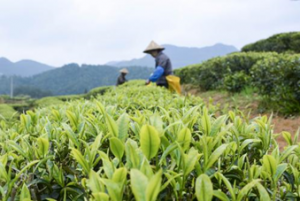 Photo from Mr. Liu (lee-oo), Summit’s central China farmer, of his organic green tea garden where this tea is grown
Photo from Mr. Liu (lee-oo), Summit’s central China farmer, of his organic green tea garden where this tea is grown
Picking Season
While teas grow year around, there are two harvest seasons per year. Spring Pick capitalizes on the terrain’s accumulation of fog, abundant rain, and mild temperatures producing the highest quality teas. These conditions are crucial to the plants ability to concentrate nutrients, especially antioxidants and flavonoids, in the leaves. These teas are never picked in the summer months due to how hotter and drier conditions bring out bitterness in the leaves. Summit’s Organic Dragon Well is currently from the 2019 Spring Pick
Special Handling
At the base of Wuyi Mountain is a lake that creates a unique microcosm for growing tea. The Lake District is the home of China’s quintessential green tea: Dragon Well.
fixation→rolling→baking(Dragon Well belongs to green tea)
History
Grown exclusively for the Emperor of China and his court, Dragon Well was the most sought after of all China’s teas. Every 7 years all the tea farms in the district are randomly redistributed to the same hereditary family groups to be farmed before passing on to the next farmer. It was to the gate of one of these farmers that our Summit founder went to ask permission to buy their teas and import them to the U.S. This privilege was finally granted after earning the respect of the farmer by working beside his cultivators, pickers, sorters, preparers, and dryers for a week in 2005. Summit Tea was born that week and going directly to the farmer became Summit’s DNA from the beginning. The tea leaves are loosely packed in mylar bags to avoid breaking and the cases shipped directly from central China to the Port of LA, where Summit picks them up 5-6 weeks later.
Jasmine Pearl – Hand Rolled Green Tea Pearls
Ecological Conditions
Climate: Semi-tropical, overcast foggy climate
Altitude: 600m
Location: Jiaocheng Tea District, Fujian Provence, PRC China
Picking Season: Spring Pick (Late March > Mid-May) Fall Pick (Mid-August > Late September)
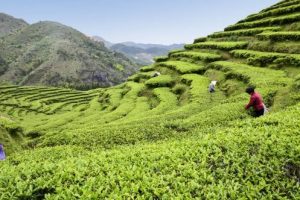
Photo from Mr. Liu (lee-oo), Summit’s central China farmer, of his white tea garden where the pearl teas are grown
Picking Season
While teas grow year around, there are two harvest seasons per year. Spring Pick capitalizes on the terrain’s accumulation of fog, abundant rain, and mild temperatures producing the highest quality teas. These conditions are crucial to the plants ability to concentrate nutrients, especially antioxidants and flavonoids, in the leaves. These teas are never picked in the summer months due to how hotter and drier conditions bring out bitterness in the leaves. Summit’s Jasmine Pearls are currently from the 2019 Spring Pick
Special Handling
Picking is timed to cool early mornings when the leaves are the most tender. Picked teas are withered in the sun for approximately 1 hour and hand-rolled into pearls (one artisan will produce about 1.5kg of pearls a day). Next, multiple layers of green tea pearls are alternated with jasmine flowers which transfer fragrance and taste as the flower petals slowly wilt onto the tea. This process is repeated three times for Summit’s jasmine pearls. The infused pearls are then gently baked in an inclined revolving oven to remove moisture and are vacuum packed in mylar bags. Cases of these bags are sent to the coast in a container for shipping to the Port of LA, where Summit picks them up 5-6 weeks later.
History
Jasmine Pearls originated during the Han dynasty (/hɑːn/; or pinyin: Hàncháo) which was the second imperial dynasty of China (206 BC–220 AD) and the time of the ancient Roman empire. They were first brought to Fuzhou, China by the maritime silk road. Today, Jasmine teas, in a vast variety, are the most produced scented tea in China.
Wild Black Tea – Black Tea from Uncultivated Wild Tea Trees
Ecological Conditions
Climate: Semi-tropical, overcast foggy climate
Altitude: 1000m
Picking Season: Spring pick (Late March > Mid-May) Fall pick (Mid-August > Late September)
Location: Jiaocheng Tea District, Fujian Provence, PRC China
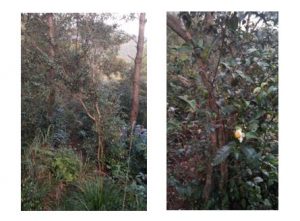 Photo from Mr. Liu (lee-oo), Summit’s central China farmer, of the wild tea trees he discovered and has protected in their natural habitat
Photo from Mr. Liu (lee-oo), Summit’s central China farmer, of the wild tea trees he discovered and has protected in their natural habitat
Picking Season
While teas grow year around, there are two harvest seasons per year. Spring Pick capitalizes on the terrain’s accumulation of fog, abundant rain, and mild temperatures producing the highest quality teas. These conditions are crucial to the plants ability to concentrate nutrients, especially antioxidants and flavonoids, in the leaves. These teas are never picked in the summer months due to how the hotter and drier conditions bring out bitterness in the leaves. Summit’s Wild Black teas are currently from the 2019 Spring Pick.
Special Handling
Pickers tromp into the brush twice a year to pick the wild tea preserve. Trees are not cultivated in trimmed rows as typical but allowed to grow naturally. As black tea starts as green tea leaves, the picking is timed to cool early mornings when the leaves are the most tender. Picked teas are spread out on a flat patio and withered (water evaporated) in the sun for approximately one day where they begin to turn brown, much like how a cut apple will turn brown as it oxidizes in the air. The teas are gathered and brought indoors to start the fermenting process that will turn the withered leaves into black tea. The process is overseen by the Tea Master who arrests the process at the right time and quickly bakes the leaves dry. In the process, juices from inside the leaves come to the surface where they dry, producing a robust first cup of tea. Cases of these bags are sent to the coast for shipping to the Port of LA, where Summit picks them up 5-6 weeks later.
History
According to legend, Wild teas were first identified in 2732 B.C. by the Emperor Shen Nung who discovered tea when leaves from a wild tree blew into his pot of boiling water. Black tea, except for Pu’er, was considered “spoiled” by the Chinese and not cultivated nor drank. The English, when importing tea from China by sailing ship found some tea casks damaged by water upon arrival; the tea having turned brown. These “spoiled” teas were dried and discovered to be an entirely new tea experience and taste. Chinese growers have since refined black teas to a fine art.
Filter Tips
Refer to the images below to see how to use the Summit Tea Filter:
